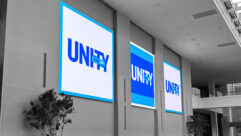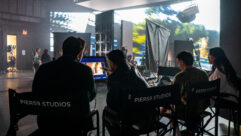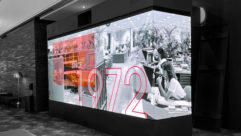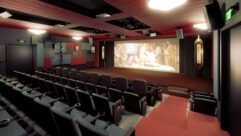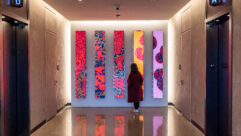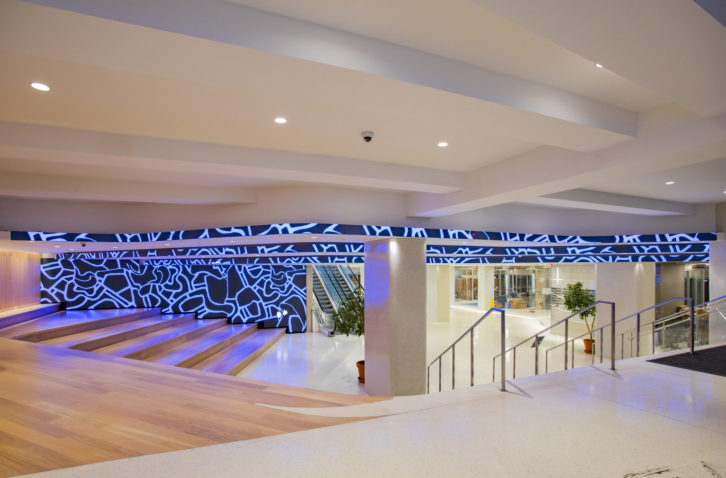
It had to happen. Eventually architects, designers, and marketers would see the potential of the incredible palette of digital display. Creative people eventually cannot resist exploring the possibilities of unique media and experiences. Once they get on board at scale, things really move. Here are some examples of lobby media art; these installations reflect a growing and powerful creative trend enabled by technology as interpreted by designers and content creators.
When One Chase Manhattan Plaza, a landmark 60-story tower, was sold in 2013, the new owners renamed the property 28 Liberty and began a multi-million dollar renovation to change the former bank headquarters into a metropolitan centerpiece. The facility’s owner, Sun Glory, Ltd. was assisted by Gardiner Theobald, who served as owner’s representative.
The project team included Gensler’s New York office, who did the architectural design, Pentagram, who lead graphic design, and Technomedia, who designed, engineered, procured and installed the entire LED system.
Technomedia oversaw the development of the creative brief and the RFP selection process of the media design team, and selected digital content creation studio, Float4 to create, produce and manage the content pieces for the installations.
The renovation decisions at the building were centered around its reinvention from a corporate entity to a modern hub. The multipurpose displays and captivating digital content act as a tool for distributing information about the building itself, local events and internal announcements. Regarding its aesthetic allure, the ground floor lobby display attracts attention from people on the sidewalk. These additions, along with other upgrades, make 28 Liberty an attractive base for tenants and passersby alike.
“The content capsules were created for three very different displays that share different portions of the space: the main lobby screen, the retail display which is on the floor right beneath the lobby and finally the adjacent ceiling ribbons that provide elegant accents,” Simionescu continued.
“One of my favorite capsules is data driven and displays visuals depicting lower Manhattan and weather conditions that are sourced in real-time. It’s a great way to convey information elegantly. Interstitials, which we use as transitions between content capsules, were also created to echo the property’s iconic art pieces such as the Dubuffet Sculpture and Isamu Noguchi’s Rock Garden.
The “Plaza” LED system is installed over a five-story escalator bay, requiring the creative engineering and construction skills of Big Show Construction Management, who managed the installation for Technomedia. A pair of RealMotion servers are responsible for delivering the content, which interfaces with Smart Monkey’s ISAAC system to provide an extremely easy-to-use content management solution. Through this combination, the property managers can arrange daily schedules, add new content, and use templates to update content in real time
“We developed the content management solution so the owners can benefit from a solution that combines performance with flexibility and reliability. Ultimately, the goal was to maximize the impact of the expansive lobby and retail space,” Simionescu said. “By presenting Float4’s creative content on large, bright digital displays, 28 Liberty has found a future-forward solution for enhancing its space, supporting its tenants, and creating a magnetic energy for people passing through.”
When one of the world’s largest high-resolution video walls was due for a technology refresh, media and Internet company IAC chose Christie CorePlus Series LED tiles and Xpyder X80 multi-screen windowing processors to supply a flexible and design-forward platform for upgrade its lobby installation at its New York City headquarters.
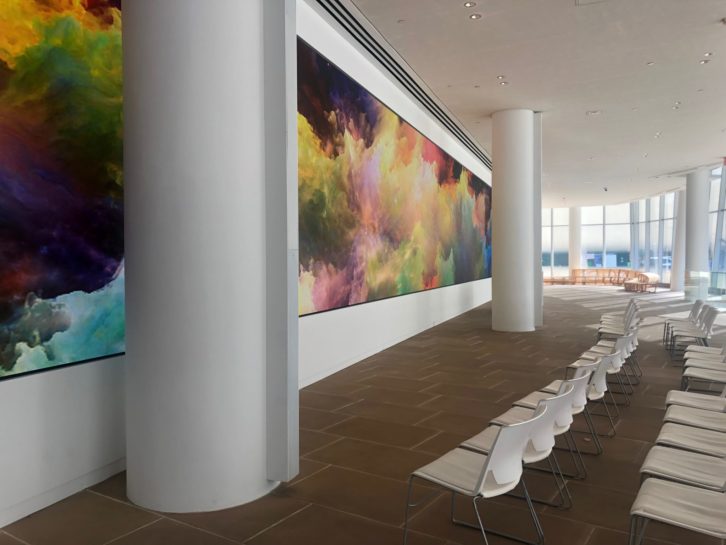 IAC occupies a striking Frank Gehry-designed building overlooking the Hudson River. The lobby boasts two separate video walls. At 120-feet long by 10 feet-high, the larger west wall spans almost the entire city block of the headquarters. It can be seen by passersby on the street, drivers on the West Side highway and even glimpsed from across the river.
IAC occupies a striking Frank Gehry-designed building overlooking the Hudson River. The lobby boasts two separate video walls. At 120-feet long by 10 feet-high, the larger west wall spans almost the entire city block of the headquarters. It can be seen by passersby on the street, drivers on the West Side highway and even glimpsed from across the river.
The east wall, measuring 20 by 10 feet, tops the security reception desk. The walls run 24/7 displaying IAC-branded content. The impressive lobby is also a coveted rental venue for high-end corporate events, during which the video walls display custom content using live sources and a backdrop.
Christie partnered with integrator VCA on the video walls’ refresh, which resulted in a system that will remain state-of-the-art for a long time, according to VCA. The video walls have undergone several technology upgrades over the years, and the latest revamp was intended to increase the walls’ video resolution to display content at 4K at 60Hz. The new installation also features 12-bit color depth and High Dynamic Range (HDR) in addition to support for 12G SDI signals, when the need arises.
“The project marks the third generation of Christie Spyder products driving the video walls,” notes Victor Vettorello, Senior Applications Specialist, Content Management and Processing, Christie. “IAC’s first video walls used the Spyder 200-300 series, working in tandem with rotated blended projectors. The second-generation video walls used laser phosphor display tiles, operated with multiple Spyder X20s. Now, the new video walls are Christie CorePlus Series LED tiles, with 1.4mm pixel pitch, paired with Christie Spyder X80 multiscreen windowing processors. IAC wanted to stay with the latest-generation of Spyder for the cutting-edge technology, reliable performance and comfort level they have come to enjoy with Spyder products.”
VCA led IAC to the Christie CorePlus solution. At this scale the combination of high resolution, advanced processing and routing required VCA to perform extensive testing of the system resulting in many instances where the components were integrated as industry firsts.
One Spyder X80 and one backup unit are dedicated to each video wall for 100 percent redundancy. The pixel density of the X80 enables just one unit to deliver 4K content to each video wall, simplifying the systems while increasing the operating efficiency.
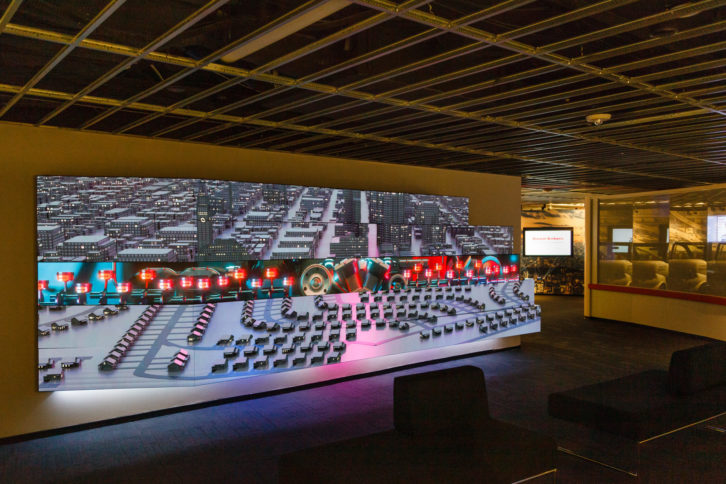 The expansive west wall is comprised of 77 CorePlus LED tiles and the east wall 13; both walls are six tiles high. Christie CorePlus features Macroblock driver-integrated circuits, ensuring delivery of high-image uniformity and performance. Multiple Christie E600 LED controllers are used to interface with signals to both walls. The Spyder X80 can easily handle the 53 million pixels required for the west wall, and its 12 inputs and 8 outputs are more than sufficient for managing IAC’s 4K content sourcing and delivery.
The expansive west wall is comprised of 77 CorePlus LED tiles and the east wall 13; both walls are six tiles high. Christie CorePlus features Macroblock driver-integrated circuits, ensuring delivery of high-image uniformity and performance. Multiple Christie E600 LED controllers are used to interface with signals to both walls. The Spyder X80 can easily handle the 53 million pixels required for the west wall, and its 12 inputs and 8 outputs are more than sufficient for managing IAC’s 4K content sourcing and delivery.
Custom floor to ceiling support structures for the two video walls were designed and engineered by rp Visual Solutions (RPV).
“The lobby, with the video walls running customized content, is an important revenue driver for the company.” says Vettorello. The fact that Spyder is so easy to manage is a big plus for those who use the lobby as a venue space.”
“Spyder X80 also offers customizable multi-viewer capabilities,” he adds. This is a really useful tool for technicians to manage and operate the system.”
Based in Cincinnati, Ohio, Hyperquake is a content creator and experience design specialist. They work on permanent installations and live events, and call themselves “Storybuilders” reflecting their approach to building an engaging environment that inspires people to act in response.
Increasingly corporations are thinking beyond the lobby to a more museum/visitor center approach to their public spaces—which fits the “storybuilding” mode. Corporations want to communicate their message through experience. So when a worldwide technology leader wanted to create the story of the Internet for their Washington D.C. headquarters, Hyperquake found themselves teamed the experiential design specialists worked with the integration firm Whitlock and Nashvillebased PixelFLEX to install a visual work of art using FLEXUltra LED video with impactresistant PixelShield.
“The client desired to pair a visually striking digital installation with compelling content that demystified and revealed the physical nature of internet infrastructure,” began David Berninger, Project Manager, Hyperquake. “Since this piece would be a digital sculpture as opposed to a simple video display, we needed a high-definition solution that was visually seamless, versatile, and cost effective; which would allow our client to demonstrate the importance of an investment in innovation to deliver the future.”
Getting started on the design of the installation, Berninger was familiar with the possibilities offered from a PixelFLEX LED video system. Replacing an outdated LCD monitor wall, he was confident that a FLEXUltra solution would allow them to better tell the story.
“We had previously collaborated with PixelFLEX on another custom installation that was a great success and we wanted to continue that rhythm,” continued Berninger. “Since LED video offers so much more flexibility than traditional displays, we were able to open up many more doors to explore the idea, and it allowed our vision for the design to be viable and executable.”
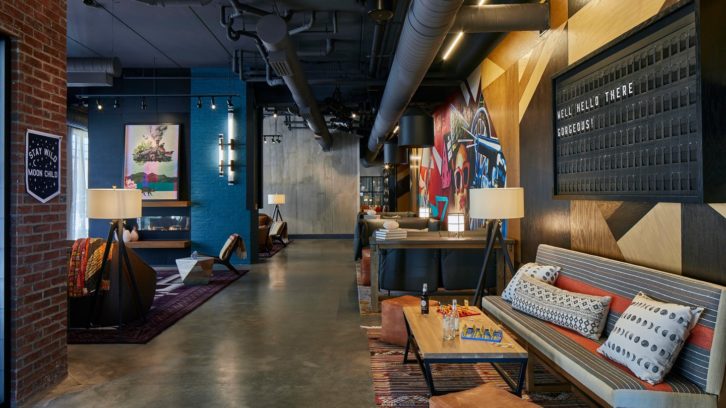 The FLEXUltra HD LED display also utilizes the impact and scratch-resistant COB PixelShield technology for long-lasting performance. The screen is 16:9 and has a 160° horizontal and vertical viewing angle. With fully font-serviceable panels for quick and easy onsite installation and maintenance, FLEXUltra operates with a 3840Hz refresh rate to eliminate on-camera scan lines and flicker, and is available in 0.9mm, 1.2mm, 1.6mm and 1.9mm pixel pitch options.
The FLEXUltra HD LED display also utilizes the impact and scratch-resistant COB PixelShield technology for long-lasting performance. The screen is 16:9 and has a 160° horizontal and vertical viewing angle. With fully font-serviceable panels for quick and easy onsite installation and maintenance, FLEXUltra operates with a 3840Hz refresh rate to eliminate on-camera scan lines and flicker, and is available in 0.9mm, 1.2mm, 1.6mm and 1.9mm pixel pitch options.
“The structure is a custom fabricated piece consisting of five wood and metal frames that are cleated to the installation surface,” added Berninger. “The media servers is tied into a Crestron system for on-demand control, the dynamic content was then created to be shuffled around as necessary and still flow together seamlessly.”
Now complete, the new digital sculpture is entitled “This is the Internet.”
“The new design is a great addition to the facility, and we have been busy expanding the capabilities of the installation further as everyone wants their own custom content for it,” concluded Berninger.
Not all lobby innovations are high pixel and high res. Inevitably designers reach forward and back in time to make modern experiences.
The quirky Moxy Hotels chain is often described as an “experiential hotel” and “funfocused brand” since it’s 2016 debut by Marriott. The guest rooms are stripped down urban dorm-chic, with design energy and expense focused on the common spaces, bars and traveler interactions.
At one of its newest locations, the Moxy Chattanooga Downtown in Chattanooga, TN, the unique experience starts as soon as guests walk in the door and see a retro/modern Oat Foundry Split Flap Display, a classic travel industry technology straight out of the 1960s.
“It’s fun to see people gasp and be surprised by the technology,” said Kelly Helton, Assistant General Manager at the Moxy Chattanooga. “What’s great is that we have instant control over the content, and it even uses different styles to flip to new messages. If the first transition is all the flaps flipping simultaneously, the next transition might be a wave from left to right.
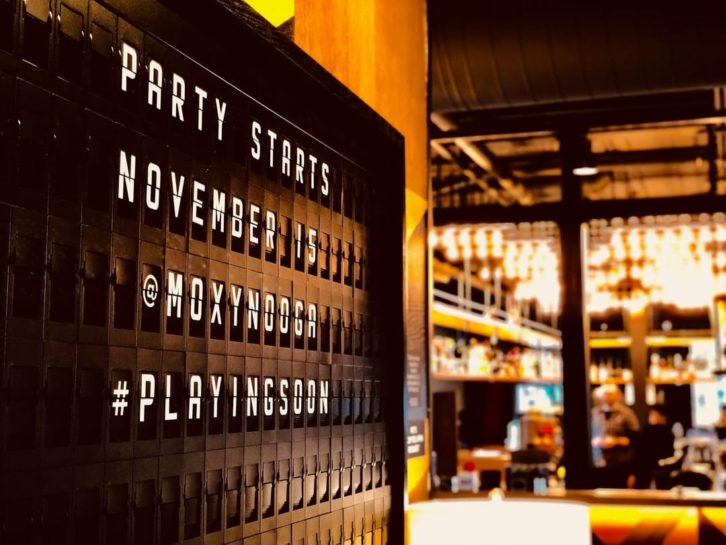 The 6 row by 24 column Oat Foundry Split Flap Display is a multi-use messaging board, allowing the hotel to program any messages it desires and to create a schedule for automated daily communication with guests. The message changes every 15 seconds, so guests always have something new to see and can easily grab a photo or video of the flipping in action. The technology can share fun quotes and inspiring messages, in addition to including custom welcome messages for parties or groups of guests.
The 6 row by 24 column Oat Foundry Split Flap Display is a multi-use messaging board, allowing the hotel to program any messages it desires and to create a schedule for automated daily communication with guests. The message changes every 15 seconds, so guests always have something new to see and can easily grab a photo or video of the flipping in action. The technology can share fun quotes and inspiring messages, in addition to including custom welcome messages for parties or groups of guests.
According to Mark Kuhn, CEO and Founder of Oat Foundry, Moxy Chattanooga Downtown is the perfect place to show off the classic style of its Split Flap Display and revive a bit of American travel history. “The goal is to encourage people to have fun, to promote guest interactions, to have them leave saying ‘the hotel was one of the best parts of this trip.’ “
Founded and operated by Philadelphia natives, Oat Foundry is an agency of engineers, a fully capable engineering design studio in a prototyping and light manufacturing facility. Oat Foundry has Split Flap Displays in operation domestically and internationally, with installations in the United States, UK, Costa Rica, Mexico, Canada, Hong Kong, and Azerbaijan.


